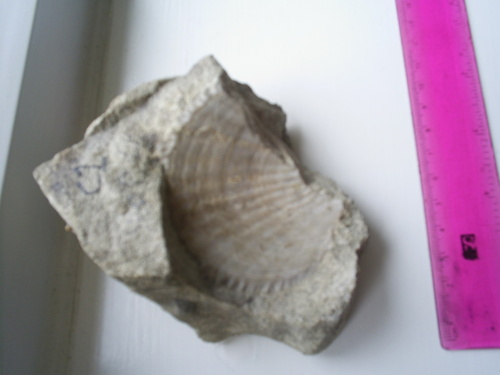fishlizard.discoveringfossils.co.uk
Shells and such.
A listing of Bivalve fossils in the collection.
Bivalves are molluscs with two-part symetrical shells that live through filter-feeding. They are similar to, but distinct from, the far older race of creatures called brachiopods. Brachiopods have a pedicle foramen - that is, a small hole at the tip of their pedicle or 'beak'. Brachiopods typically lived attached to a hard substrate via this hole, where as bivalves lived loose in the sediment or attached via abyssal threads to rocks (much as in the same way modern mussels do). Bivalves were common throughout the mesozoic and indeed continue to thrive today, whilst brachiopods have declined and are represented by very few species.
Gryphea cf Dilatata
Collected from Furzy Cliff, east Weymouth. Oxford clay mudslips.
Gryphea dilatata is the iconic fossil oyster of the mesozoic. Occasionally attaining the size of a small dinnerplate, it lived in massive colonies of oyster beds, and is hence abundant at the localities it occurs. This particular specimen came from from Weymouth in 2007, and is one of two I brought back. Pickings were rich though, with approx 40+ found in an hour of searching. It's smaller cousin (Who we'll deal with next) is the frequently encountered 'Devils Toenail' of the jurrassic coast.
Gryphea arctua
A small selection of these iconic bivalves. Virtually every collection will have one of these 'devils toenails'. These particular examples came from Doniford Bay, Watchet, with the big one at the top coming from Lyme Regis. I was pretty happy when I found that! Blue Anchor bay on the somerset coast is a good place to find these, with them regularly being washed out and found amongst the foreshore pebbles.
Luscinia Cf. miniscula
Sorry for the poor photo - my camera does not like close ups. (I did have a brilliant macro function on my other - but the camera died on a trip to charmouth. A word of advise: camera + gravity + rocks is not a happy equation )
)
Anyway, this little guy was found in the mud encasing a Gryphea from Weymouth, and was discovered when I cleaned it up in the sink. A kind of Jurrassic special offer I suppose. Anyway, this is a simple bethnic filter feeder that probably lived in a short burrow, with siphons to draw in water. I guess he must have wanted some company too.
Neithea cf gibbosa
A swift jump to the Cretaceous now, and with a specimen I must send to my good friend Fiona for a bit of 'air time'. (No, fiona isn't a stunt wild sky-diver. She's actually very handy with an airpen. Just what many of my specimens need. Besides, I think this little chap would feel a bit queasey looping the loop at at eight thousand feet).
Upper Greensand, White Sheet down, Mere, Nr Warminster, Wiltshire. 2002. Surprisingly the only fossil I have found at this particular location - an exposed ancient quarry cutting.
Spondylus cf latus.
Again, another gremlinised photo. They keep playing with my camera.
This too is a candidate for prep work, which I ashamedly still havn't got around to six years after collecting it (I'm a busy guy, alright?!!). This would look much better from the other side - Spondylus has many rows of fantastic spines. just my luck to have a rock which split this way. Still, I'll keep it untill I get a better one.
...
...
...
...
Oh, yeah. almost forgot. Here is the necessary boring stuff:
Upper Greensand , Mere, Nr Warminster, Wiltshire.




